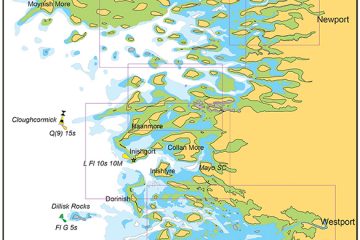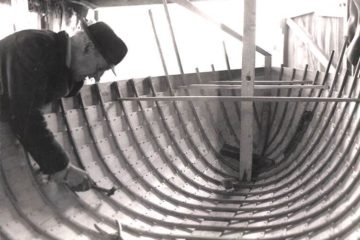by Bob Brown
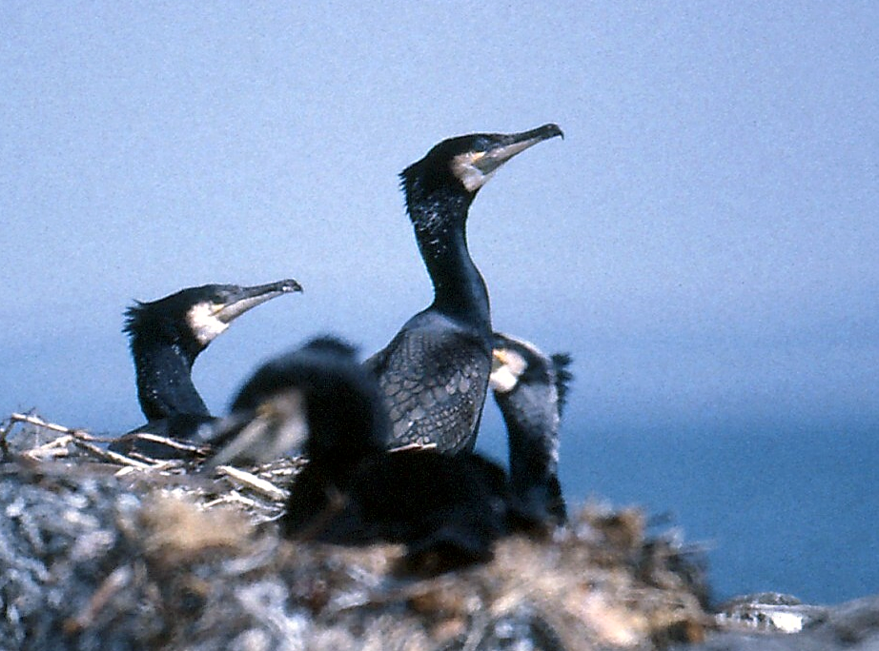
Bird Island, Strangford Lough. Seen close at hand, cormorants’ ‘scaly’ patterned plumage is quite attractive.
We’ve all seen them: dark, brooding birds, perched on rocks, shipwrecks, harbour pilings, navigational beacons, and small islands. They are the archetypal residents of our coast, on exposed headlands, sheltered harbours, and even inland lakes. And, perhaps they look a bit sullen, lurking there in contrast to the moods of those of us who enjoy being out on the water.
Many people take them for granted, whilst others are frustrated by the difficulties of deciding whether that bird is either a cormorant or a shag. So, for starters, let’s clear that up. Firstly, the cormorant is visibly heavier built and larger than the shag, but unless they sit side by side, that may be difficult to judge. The cormorant often has a whitish ‘chin’ and a rather thick neck, whilst in the breeding season it has a white patch on the rear flank, that can be seen quite easily when in flight. They often pose with wings outstretched, apparently drying in the sun and wind. By contrast, the shag looks a little darker, although if you get a close view, it appears wonderfully iridescent. It also has a tuft of feathers on its crown, particularly conspicuous in the breeding season, or when the wind is from behind, lifting the feathers. Both species have longish sharp bills, the shag particularly so.
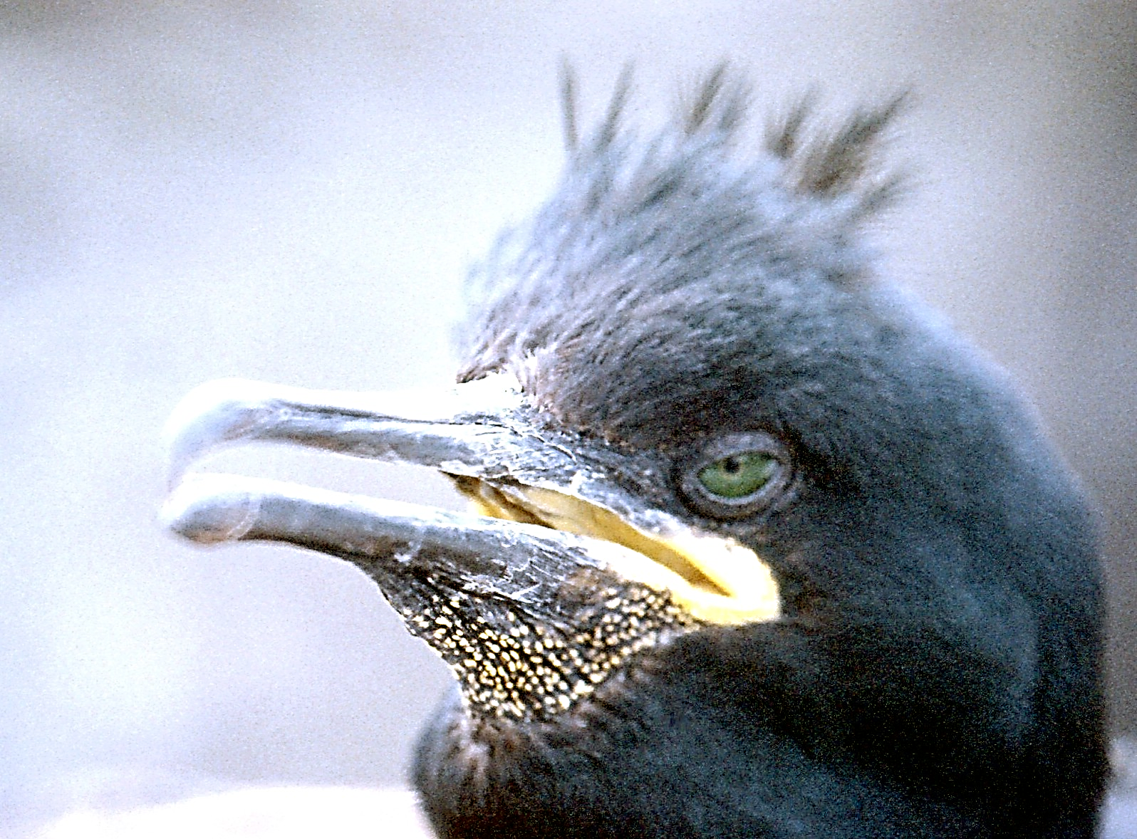
A shag on the Farne Islands; the breeze from behind has lifted its crest.
Another factor that helps with identification, although it’s not definitive, is location. Cormorants tend to prefer the more sheltered areas of coast – inlets, bays, and estuaries, as well as harbours. A continental race of cormorants is also found in inland rivers and lakes. Shags are more a feature of exposed coasts, offshore rocks, and during nesting, low down on exposed seabird cliffs, often on islands. And, if you’re visiting a derelict lighthouse, watch out from above – they like the old broken floor joists, and after inspecting you they may turn around and point the other end! Unlike cormorants, shags are hardly ever seen flying over land. But of course, exposed coasts often merge into sheltered ones, and there are occasions when the two species may be seen together. At least that gives us a chance to compare them!
Both species are well adapted for fishing in shallow waters. They float low in the water – sometimes the cormorants seem half submerged – and a dive usually starts with a brief seal-like leap, more pronounced in the shag. With legs and feet set well back on the body, these drive the bird down (the wings are not used for swimming, unlike those of puffins and guillemots) into the kelp and other seaweeds, or in the shag’s case, into shoals of sand eels and other small fish a short way offshore. The kelp fringes are a particularly productive hunting habitat, with small fish and eels hunting for seabed invertebrates lurking amongst the fronds. There, the long neck, with snake-like flexibility, is ideal for seizing prey, the razor-sharp bill holding firmly until the bird surfaces and it can manoeuvre the victim into being swallowed head first.
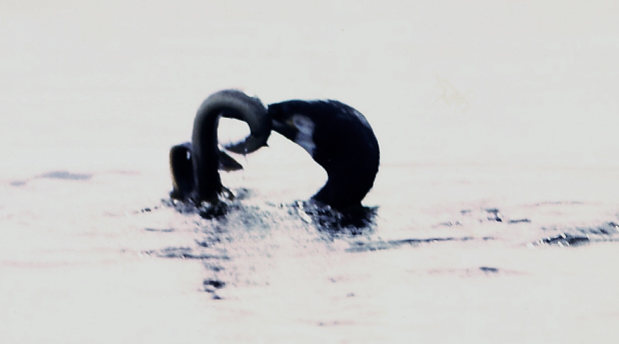
The last moments of an eel’s life was taken by C Douglas (‘Jimmy’) Deane, nature correspondent for the Belfast Newsletter in the 1980s. A characteristic scene where cormorants find good hunting during high water over weedy shorelines.
Both species construct large nests of seaweed and other coastal debris. Around Ireland, the cormorants tend to nest on more level sites like low lying islands (sometimes trees inland) whilst the shags opt for ledges on cliffs. One cormorant nest I was monitoring was nicely constructed with a lady’s tights wound round, binding the other materials. The nests gradually get coated in droppings and regurgitated fish, so that a visit on a nice hot summer’s day is a rather fragrant experience…

Cormorant eggs and a newly hatched chick. Note the central egg – a cheeping chick soon to enter a new world.
And then there is the egg laying of course; the cormorants’ eggs a chalky white, the shags’ the palest blue, a tint which seems to fade and disappear with the sunlight and general muck. But soon a chipping starts to occur, and even before the chicks have fully emerged, they are cheeping, calling for attention. When they do come out, they can’t really be thought of as beautiful – a naked leathery dark grey colour, betraying the essentially reptilian ancestry of all birds. But beauty is in the eye of the beholder, and their dedicated parents ensure that growth is rapid on a diet of protein-rich fish; both striving to keep up with the chicks’ voracious appetites. As they acquire feathers, and eventually make it to the waters around the nest site, they can be spotted easily – a lighter, brownish colour, than the adults, pale on the belly.
For several years, I helped with ringing cormorants as part of an effort to understand their travels outside the breeding season, and we were rewarded with returns coming from as far from France, Spain, and Portugal, as well as more local movements. Putting a ring on a cormorant’s leg is an interesting exercise (note: bird ringing can only be done under license in most European countries). The chick must be fairly mature, but not fledged, so still devoted to its nest. It has to be gently held, and here’s the challenging bit – avoiding a stab in the eye, whilst you position the leg so that a colleague can attach the numbered ring, whose details are later lodged with the British Trust for Ornithology or another relevant national organisation. This process is often accompanied by projectile defaecation, or regurgitation. And, whilst the unharmed chick settles back with minor loss of dignity, the ringers are seriously unwelcome back home in the kitchen!
This recording of bird movements is vital for our understanding of all the aspects of a species’ ecology. No chain is stronger than its weakest link as we all know too well. So, the benefits from preserving the habitat or key location of a species at one part of its yearly cycle are seriously undermined if key sites at all other stages of its migration are not protected. By this means, networks of key sites can be protected for a species’ flyway. This is embodied under the legislation enacted under the EU Birds Directive. (The fate of such sites in the UK following Brexit worries me a lot, but don’t get me started on that).
If you do find a bird (often it may be dead, washed up, or perhaps a traffic fatality) with a ring on, try to get the details (use a glove or other protective material) and submit it to the relevant organisation, giving at least date, location, and circumstances. The species will already be on their database via the numbered ring, so if you can’t identify it, it doesn’t matter so much. BUT, if you think there is the slightest chance it may be an avian flu victim, do not touch it.
Finally, I can’t resist:
| The Common Cormorant or Shag by Christopher Isherwood: The Common Cormorant or Shag Lays eggs inside a paper bag. The reason you will see no doubt It is to keep the lightning out. But what these unobservant birds Have never noticed is that herds Of wandering bears may come with buns” And steal the bags to hold the crumbs. |
